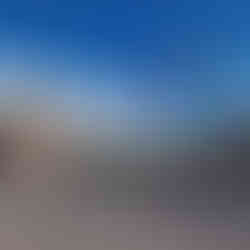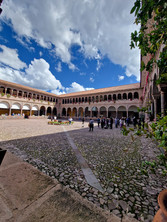After the vibrant streets and coastal beauty of Lima, my Peruvian adventure with World Treks, took me to the ancient city of Cusco, the historical heart of the Inca Empire. Located in the Peruvian Andes at an elevation of 3,400 meters, Cusco offers a unique blend of native culture and Spanish colonial architecture, making it a fascinating destination for history enthusiasts, adventure seekers, and cultural lovers.

Flying into Alejandro Velasco Astete International Airport, the panoramic view from the plane was breathtaking. Snow-capped peaks rose majestically above the clouds and at the bottom, green valleys could be seen. Stepping off the plane, it doesn’t take long to feel the altitude; your breathing gets heavier, and you may feel lightheaded for a few hours. Remember to stay hydrated, and if you are planning to hike the Inca Trail, stay in Cusco for a couple of days to fully acclimatize.
Making the most of my time in Cusco, I spent my first day exploring the historic center. Cusco is known for its vibrant art scene, reflecting indigenous and colonial influences. The city's gallery stores are filled with works from the Cuzco School of Art, a term used for the blending of European techniques and indigenous art practices that flourished from the 16th through the 18th century. Additionally, local shops offer exquisite handmade textiles, ceramics, and jewellery, each piece telling a story of the region's cultural heritage.
Cusco is also a hub for superb textiles made from the soft wool of alpacas. Sweaters, scarves, gloves, hats, and blankets are known for their warmth, durability, and unique designs that reflect centuries-old weaving traditions. Alpaca clothing is not only a symbol of Peruvian heritage but also a sought-after product for visitors seeking authentic, high-quality apparel. Shopping for alpaca products in Cusco offers a connection to the rich culture of the Andes, blending traditional craftsmanship with modern fashion.
The Plaza de Armas, the city's main square, is surrounded by stunning colonial buildings, including the impressive Cathedral of Cusco and the Church of the Society of Jesus (Iglesia de la Compañía de Jesús). Both structures are adorned with intricate Baroque facades and house priceless collections of colonial art.
The Church of the Society of Jesus (Iglesia de la Compañía de Jesús) is a prime example of Spanish Baroque architecture. Built by the Jesuits in the 16th century, it features intricate altars and an impressive façade.
The Cathedral of Cusco, built on the foundations of an Inca palace, is a testament to colonial architecture. It houses a magnificent collection of art, including the famous painting of the Last Supper with a unique Andean twist—Jesus and his disciples dining on guinea pig. The first area used for religious acts was built in what is currently the Church of Triunfo next to the Cathedral Basilica. The Spanish conquerors requested the creation of the Bishopric of Cusco, which was headed by Fray Vicente Valverde.
The Cathedral of Cusco combines elements of Gothic, Renaissance, and Baroque styles. It has two strong towers and side entrances in the Mannerist style, while the main entrance is subtly Baroque. Inside, it features beautiful altars in Renaissance, Baroque, and neoclassical styles. The carved wooden lectern and choir stalls showcase remarkable Cusquenian craftsmanship. The cathedral also has an impressive collection of paintings from the Cuzco School, including works by Diego Quispe Tito, Basilio Santa Cruz Pumacallo, Basilio Pacheco, and Marcos Zapata, who created the unique "Last Supper" painting. The Sacristy is adorned with portraits of the Bishops of Cusco. The choir is made of cedar wood and combines Baroque and Neoclassical styles. The main altar, decorated with gold and silver, used over 1,250 kilos of silver. The cathedral holds around 300 paintings by indigenous, mestizo, and European artists. In the Silver Room, the 1733 Baldaquin piece, donated by Francisco Guyzueta Maldonado, stands out.
Just a short walk away is the Coricancha Temple, also known as the Temple of the Sun, one of the most significant and sacred sites in Cusco. Originally the most important temple in the Inca Empire, it was dedicated to Inti, the Sun God, and was once adorned with gold plates and filled with golden statues. The temple's walls, made from finely cut and precisely fitted stones, demonstrate the Inca's advanced building skills. Following the Spanish conquest, the Santo Domingo Convent was built atop the ruins of Coricancha, creating a striking blend of Inca and colonial architecture. Today, visitors can see remnants of the original Inca temple integrated with the colonial convent, a powerful symbol of Cusco's layered history. The site also displays various archaeological findings, which offer further insight into the temple's historical and cultural significance.
Cusco is also a paradise for food lovers. The city's culinary scene blends traditional Andean ingredients with contemporary techniques, featuring dishes like alpaca steak, quinoa soup, Lomo Saltado (stir-fried beef mixed with onions, tomatoes, and aji peppers, served with rice and French fries). Another local dining experience not to be missed is Cuy al Horno (Roasted Guinea Pig), a Peruvian delicacy where guinea pig is marinated in local spices and slow roasted until the skin becomes crispy, served with potatoes and a rich, spicy sauce. I wasn’t quite ready for this experience yet, so maybe another time.
Although I didn't get a chance to visit the San Pedro Market, I've read so much about it that I highly recommend experiencing its vibrant atmosphere and exploring its rich variety of offerings, including fresh vegetables, spices, handicrafts, and local cuisine. It's known for showcasing authentic Andean culture and flavours, making it a must-visit for anyone exploring Cusco.
Cusco is more than just the gateway to Machu Picchu; it's a city where history and modernity coexist harmoniously. Its streets tell tales of ancient civilizations, and its people proudly hold their rich cultural heritage. Whether you're exploring ancient ruins, indulging in culinary delights, or simply taking in the breathtaking scenery, Cusco offers an unforgettable experience. As I prepared to leave this enchanting city, I couldn't help but feel a deep sense of gratitude for the experiences and memories I'd gathered. I knew that the city's energy, spirit, and beauty would stay with me long after my journey had ended.
Next stop: Sacred Valley's hidden gems. Stay tuned for my adventures in this mystical region!












































